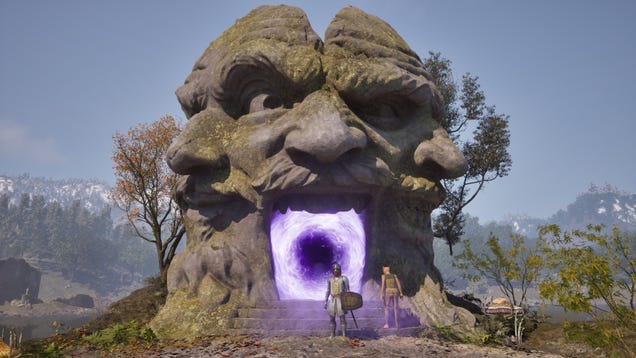
Treat your eyes and your wallet to a quality screen.
Black Friday officially starts on November 25 and for many of us that means a chance to grab a monitor upgrade. If you’ve been struggling along with a 24-inch 1080p for the longest of times, then the sales season can be a great time to finally pull the trigger on something not only bigger, but significantly better too.
Whether you’re looking at a shift to IPS, VA, or going down the OLED route, getting your esports game on with a high-refresh panel, or simply treating yourself to a big ol’ 4K monitor, there are plenty of quality monitors out there for gamers. It helps to go in focused though, work out what screen you want and don’t get distracted.
The good news is that monitor technology has come on a lot recently, with previously prohibitively expensive and hard-to-get combinations such as high-refresh, high-resolution panels, now available at reasonable price points. 120Hz 4K screens used to demand a serious premium, but you can already enjoy $200 off the Acer Nitro XV273K, which is a 4K monitor that’ll hit 120Hz (144Hz with double DisplayPort connections) and can now be had for $500.
We’re curating all the best Black Friday PC gaming deals right here.
If you’re looking for inspiration as to the kind of screen you want to hunt down, don’t forget we’ll be here to help and will be highlighting the best deals we found over on our Black Friday gaming monitors hub, then here’s a rundown of what we think is important for any new screen purchase:
Resolution: This provides the biggest impact on the fidelity of your gaming and the higher you go, the better. The downside is that you’ll need a top-tier graphics card to hit smooth frame rates with all the pretties turned up high. It can be a balancing act if you haven’t upgraded your graphics card for a while, but you’ve got your eye on the next generation—getting a monitor that will let you play smoothly today but absolutely rock when you do upgrade. It’s worth bearing in mind that a good monitor will last you a couple of GPU generations, so aim for tomorrow where possible.
Refresh rate: The higher the refresh rate, the smoother your gaming. Again though, you’ll need a good graphics card to produce all those frames. If you play competitive shooters, then you should see 120Hz as the minimum, with serious esport-types eyeing up 240Hz and even 360Hz. Faster 480Hz/500Hz panels are coming, although most mortals are going to be hard-pushed to feel the difference.
Panel Type: There was a time when gamers were only really interested in TN panels, simply because that was the only technology quick enough for our needs. Technological improvements mean that absolutely isn’t the case anymore though, and these days IPS and VA are just as speedy and offer much better color reproduction, contrast, and viewing angles. To the point where TN is being pushed out of the market.
OLED panels are starting to appear too, and these offer incredible response times (0.1ms), stunning color reproduction, and HDR that doesn’t fundamentally suck. The simply stunning Alienware QD-OLED AW3423DW is a great example of what these screens can do, and is currently available for $100-off over at Dell for $1,199.
Size: How big a screen do you need? A bigger screen can give you a more epic feel, especially if you’re looking at an ultrawide model, but you need to marry this with the screen’s native resolution so that you don’t end up with big blocky pixels. At the same time, you don’t want too tight a pixel pitch—Dell’s early 24-inch 4K panel was hard work in Windows when it first came out, although the scaling in Windows has improved a bit since then. You want at least 110 pixels per inch (PPI) for a reasonable experience for desktop use. Use a PPI calculator to help work out the PPI for any prospective screen.
G-Sync & FreeSync: These technologies prevent screen tearing by synchronising to the output of your graphics card as opposed to just updating at a predefined interval. The result is a much smoother experience and one that works well at high frame rates as it does at low ones. The Nvidia-backed G-Sync tends to be more expensive as it requires physical hardware in the monitor. The good news is that a lot of modern FreeSync monitors are G-Sync compatible—you can check on Nvidia’s site.
Gaming monitor crib sheet
(Image credit: Future)
Unlike PCs, graphics cards, CPUs and plenty of other components, coming up with a list of what prices you can expect to pay for a good gaming monitor isn’t so easy. Instead, it’s better to highlight the monitors that we think are great examples of what is available right. Be sure to check out the best gaming monitor page for our fave displays though, and if you see one of those on sale, then it’s going to be worth grabbing.
4K 27-inch 144Hz – Acer Nitro XV273K – $499 at Newegg (save $200)
4K 32-inch 144Hz – Gigabyte M32UC – $549 at Newegg (save $180)
1440p 32-inch 165Hz – Gigabyte M32Q – $329 at Newegg (save $170)
1440p 32-inch 240Hz – Aorus FI32Q-X – $489 at Newegg (save $510)
1440p 34-inch 175Hz – Alienware AW3423DW – $1,199 at Dell (save $100)
1080p 24-inch 144Hz – Acer Nitro RG241Y – $159 at Newegg (save $40)
1080p 27-inch 240Hz – LG UltraGear 27GN75B-B – $199 at Newegg (save $130)
These are just some of the examples of what is already available. We’re expect plenty more monitor deals as Black Friday really kicks off, and whatever you’re in the market for, you should find something of interest.



